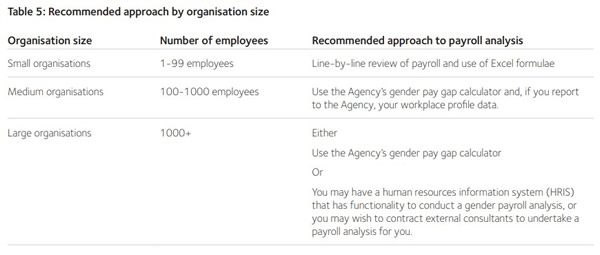WGEA data shows employers are realising the importance of doing a gender pay gap analysis with 37.7% of organisations conducting an analysis last year, an increase of almost 11 percentage points. It is important for all organisations – even those who don’t believe they have gender pay gaps – to look at your data, as you may be surprised by the results. Start the journey by following these five steps.
Step 1. Develop your business case
Why is pay equity important for your organisation? What are you trying to achieve by conducting an analysis and can you explain these reasons to your executive team? It is vital that before you even start your analysis, your business case articulates the benefits to key stakeholders, as well as to the business as a whole.
Step 2. Ensure you have leadership commitment
Gaining leadership commitment, both from the executive team and the board, is critical to achieving your pay equity objectives.
Step 3. Analyse your data
When analysing your data, it is important to remember that discovering gender pay gaps in your data does not necessarily mean that your organisation is being discriminatory, however it does mean you need to identify and determine why the gaps exist in order to find out whether those gaps are explainable and, if so, justifiable. Before you begin your analysis, you will need to determine the best analysis method for your organisation. The image below offers some general guidance. However, it is up to your organisation to decide the appropriate method to use taking into account all its circumstances.

Step 4. Communicate the results to your leadership team
This is where the leadership commitment to your pay equity strategy is vital. Having an executive team and board who are committed to your pay equity strategy will make it far easier to communicate the results and determine actions that need to be taken to address any issues.
While our reporting data shows an increase in the number of organisations conducting pay gap analyses, the number of organisations reporting those results remain low, with only 25.6% communicating results to their executive and 13.9% communicating results to the board.
Research recently released by the Bankwest Curtin Economics Centre and the Workplace Gender Equality Agency found that actions to correct gender pay gaps are three times more effective when combined with reporting to the Executive or Board. These organisations saw an average reduction of 3.3 percentage points in their organisation-wide gender pay gap in one year.
Step 5. Review, review, review
Analysing your payroll data for potential pay equity issues is not a one-time thing. Many organisations who are addressing pay equity in their workplaces say it is important to remain vigilant in analysing and monitoring pay gaps to ensure gaps don’t creep in at any point of the employee cycle. Constantly reviewing your data also ensures you maintain an open communication with your leadership team about pay equity.
Once you have completed the analysis and investigation of your pay gaps, it is important to prioritise the issues of your organisation, set clear goals around gender pay equity and develop tailored actions to achieve your goals. You may decide to build your pay equity strategy as part of your broader gender equality strategy.